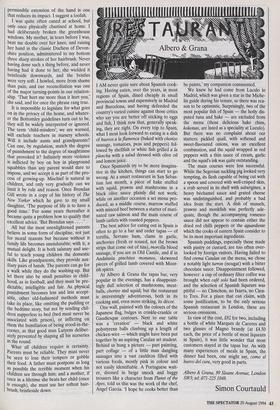1111111.1111111111W 114i,
Albero & Grana
I AM never quite sure about Spanish cook- ing. Having eaten, over the years, in most regions of Spain, dined cheaply in small provincial towns and expensively in Madrid and Barcelona, and having defended the country's varied cuisine against those critics who say you are better off sticking to eggs and fish, I think now that, generally speak- ing, they are right. On every trip to Spain, what I most look forward to eating is a dish of huevos a la flamenca (baked with chorizo sausage, tomatoes, peas and peppers) fol- lowed by shellfish or white fish grilled a la plancha with a salad dressed with olive oil and lemon juice.
Once Spaniards try to be more imagina- tive in the kitchen, things can start to go wrong. At a smart restaurant in San Sebas- tian last month, a piece of hake stuffed with squid, prawns and mushrooms in a black olive sauce plainly did not work; while on another occasion a set menu pro- duced, as a middle course, marrow stuffed with minced beef between a starter of mari- nated raw salmon and the main course of lamb cutlets with roasted peppers.
The best advice for eating out in Spain is often to go to a bar and order tapas — of tortilla, Serrano ham, clams in garlic, anchovies (fresh or soused, not the brown strips that come out of tins), morcilla blood sausage, if you are in Old Castile, and if in Andalusia pinchitos morunos, skewered pieces of grilled lamb covered with Moor- ish spices.
At Albero & Grana the tapas bar, very popular in the evenings, has a disappoint- ingly dull selection of mushrooms, meat- balls, chorizo and squid; but the restaurant is interestingly adventurous, both in its cooking and, even more striking, its decor.
One wall, painted with the colours of the Japanese flag, bulges in crinkle-crankle or Gaudiesque contours. Next to our table was a 'creation' — black and white polystyrene balls climbing up a length of chicken-wire — which might have been put together by an aspiring Catalan art student. Behind us hung a picture — part painting, part collage — of a little man dangling sausages into a vast cauldron filled with various foods, mostly pink in colour and not easily identifiable. A Portuguese wait- er, dressed in beige smock and baggy trousers like a character from Planet of the Apes, told us this was the work of the chef, Angel Garcia. 'I hope he cooks better than he paints,' my companion commented.
We knew he had come from Luculo in Madrid, which was given a star in the Miche- lin guide during his tenure, so there was rea- son to be optimistic. Surprisingly, two of the most popular fish of Spain — the hotly dis- puted tuna and hake — are excluded from the menu (those delicious hake chins, lcokobcas, are listed as a speciality at Luculo). But there was no complaint about our starters: pickled quail, with softened and sweet-flavoured onions, was an excellent combination, and the squid wrapped in red peppers with a thin sauce of cream, garlic and the squid's ink was quite outstanding.
The main courses were less successful. While the Segovian suckling pig looked very tempting, its flesh capable of being cut with a spoon and covered with well-crisped skin, a crab served in its shell with aubergines, a heavy béchamel sauce and grated cheese was undistinguished, and probably a bad idea from the start. A dish of mussels, prawns and monkfish was perfectly ade- quate, though the accompanying romesco sauce did not appear to contain either the dried red chilli peppers or the aguardiente which the cooks of eastern Spain consider to be its most important ingredients.
Spanish puddings, especially those made with pastry or custard, are too often over- looked by foreign visitors. Having failed to find crema Catalan on the menu, we chose a notably light turron (nougat) with a bitter chocolate sauce. Disappointment followed, however: a cup of ordinary filter coffee was brought when café solo had been ordered, and the selection of Spanish liqueurs was pitiful — no Chinchon, no Ixarra, no Cien- to Tres. For a place that can claim, with some justification, to be the only serious Spanish restaurant in London, these are serious omissions.
In view of the cost, £82 for two, including a bottle of white Marques de Caceres and two glasses of Magno brandy (at £4.50 each, the price of a bottle of most liqueurs in Spain), it was little wonder that most customers stayed at the tapas bar. As with many experiences of meals in Spain, the dinner had been, one might say, como el huevo del cura, very good in parts.
Albero & Grana, 89 Sloane Avenue, London SW3; tel: 071-225 1048.
Simon Courtauld


















































 Previous page
Previous page